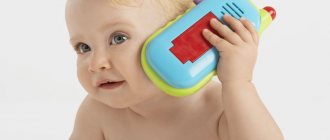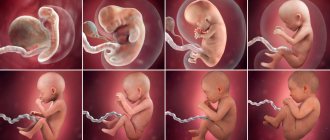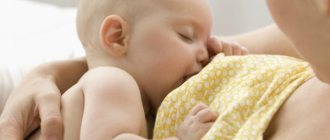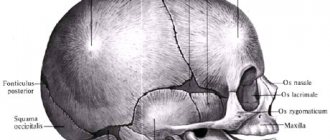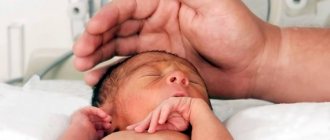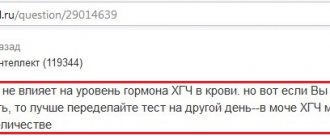Once born, a newborn not only has its own anatomical and physiological characteristics, it perceives the world around it in a special way. Despite his apparent helplessness, he already knows a lot: to close his eyes in bright light; smell, especially the smell of mother's milk; distinguish loud sounds.
Children in the first weeks of life are not yet able to focus their gaze, so the contours of all the objects around them seem blurry to them, and the only colors available to perception are black and white.
It is believed that a newborn does not perceive his mother separately from himself. However, the whole world for him is himself, his new sensations and possibilities. Only by the end of the third week of life will the newborn begin to distinguish his mother and other family members, showing this with a “revival complex” and a toothless smile.
Methodology for using unconditioned reflexes
Since in the practice of work on higher nervous activity, the unconditioned reflex is a reinforcing factor and the basis for the development of acquired, or conditioned, reflexes, the question of methodological techniques for using the unconditioned reflex becomes especially important. In experiments on conditioned reflexes, the use of an unconditioned food reflex is based on feeding the animal with certain nutrients from an automatically fed feeder. With this method of using an unconditioned stimulus, the direct effect of food on the receptors of the animal’s tongue is inevitably preceded by a number of side irritations of the receptors related to various analyzers (see).
No matter how technically perfect the feeding of the feeder is, it certainly produces some kind of noise or knocking and, therefore, this sound stimulus is the inevitable precursor of the truest unconditioned stimulus, that is, the stimulus of the taste buds of the tongue. To eliminate these defects, a technique was developed for the direct introduction of nutrients into the oral cavity, while irrigation of the taste buds of the tongue, for example, with a sugar solution, is a direct unconditioned stimulus, not complicated by any side agent.
It should be noted, however, that under natural conditions, animals and humans never receive food into the oral cavity without preliminary sensations (sight, smell of food, etc.). Therefore, the method of directly introducing food into the mouth has some abnormal conditions and the animal’s reaction to the unusual nature of such a procedure.
In addition to this use of an unconditioned stimulus, there are a number of techniques in which the animal itself receives food with the help of special movements. These include a wide variety of devices with the help of which an animal (rat, dog, monkey) receives food by pressing the corresponding lever or button - the so-called instrumental reflexes.
The methodological features of reinforcement with an unconditioned stimulus have an undoubted influence on the experimental results obtained, and, therefore, the assessment of the results should be made taking into account the type of unconditioned reflex. This especially applies to the comparative assessment of the food and defensive unconditioned reflex.
While reinforcement with a food unconditioned stimulus is a factor of positive biological significance for an animal (I.P. Pavlov), on the contrary, reinforcement with a painful stimulus is a stimulus for a biologically negative unconditioned reaction. It follows that “non-reinforcement” of a well-established conditioned reflex with an unconditioned stimulus in both cases will have the opposite biological sign. While non-reinforcement of a conditioned stimulus with food leads to a negative and often aggressive reaction in the experimental animal, on the contrary, non-reinforcement of a conditioned signal with electric current leads to a completely distinct biological positive reaction. These features of the animal’s attitude to the non-reinforcement of a conditioned reflex by one or another unconditioned stimulus can be clearly identified by such a vegetative component as breathing.
How to develop a baby at 1 month
Each child is individual, he has his own rhythm of development. Parents can help him if they use different parenting techniques that are beneficial for social development.
Social development
The mother needs to look into the child’s eyes more often, then he will learn to recognize her face. If your baby smiles and makes funny grimaces, the baby will carefully study his facial expression. Rocking your baby in your arms and holding him gently will help him relax and feel safe.
If at 1 month you gently hug your baby and dance with her to calm music, she will feel a soothing rhythm of movement. When parents respond to the cues that the baby uses to express and describe his emotions, the baby will feel cared for, his message has been heard, and he will stop worrying.
Emotional and mental development
Children develop much faster if you work with them. A one-month-old baby's waking time is about 3-4 hours a day. During this period, the mother needs to be close to the child and keep him occupied with something. The baby needs his mother's protection, affection and care. The mother should take the baby in her arms as often as possible, lean over his crib, smile and attract his attention in every possible way. It is also necessary to talk with the child during feeding, swaddling, and bathing at night.
It is very useful to turn on quiet music, as it activates the brain. After bathing, be sure to do a light body massage. It will calm the baby and have a positive effect on the nervous system.
Note! Crying is the only signal a child can give if something is bothering him. Also, a toddler may protest by crying when his mother wants to put clothes on him. When there is a quiet and calm atmosphere in the family, the baby will feel safe and therefore develop normally.
Baby in a crib with toys
Composition and localization of unconditioned reflexes
The development of experimental technology has made it possible to study the physiological composition and localization of the unconditioned food reflex in the central nervous system. For this purpose, the very effect of an unconditioned food stimulus on the receptors of the tongue was studied. An unconditioned stimulus, regardless of its nutritional properties and consistency, primarily irritates the tactile receptors of the tongue. This is the fastest type of excitation that is part of unconditioned stimulation. Tactile receptors produce the fastest and highest-amplitude type of nerve impulses, which first spread along the lingual nerve to the medulla oblongata, and only after a few fractions of a second (0.3 seconds) nerve impulses from temperature and chemical stimulation of the tongue receptors arrive there. This feature of the unconditioned stimulus, manifested in the sequential excitation of various receptors of the tongue, has enormous physiological significance: conditions are created in the central nervous system for signaling with each previous stream of impulses about subsequent stimuli. Thanks to such relationships and characteristics of tactile excitation, depending on the mechanical qualities of a given food, in response only to these excitations, salivation can occur before the chemical qualities of the food act.
Special experiments carried out on dogs and studies of the behavior of newborn children have shown that such relationships between individual parameters of the unconditioned stimulus are used in the adaptive behavior of the newborn.
For example, in the first days after birth, the decisive stimulus for a child’s food intake is its chemical qualities. However, after a few weeks, the leading role passes to the mechanical properties of food.
In the lives of adults, information about the tactile parameters of food is faster than information about chemical parameters in the brain. Thanks to this pattern, the sensation of “porridge”, “sugar”, etc. is born before the chemical signal arrives in the brain. According to the teachings of I.P. Pavlov on the cortical representation of the unconditioned reflex, each unconditioned irritation, along with the inclusion of the subcortical apparatuses, has its own representation in the cerebral cortex. Based on the above data, as well as oscillographic and electroencephalographic analysis of the spread of unconditioned excitation, it was established that it does not have a single point or focus in the cerebral cortex. Each of the fragments of unconditional excitation (tactile, temperature, chemical) is addressed to different points of the cerebral cortex, and only the almost simultaneous stimulation of these points of the cerebral cortex establishes a systemic connection between them. These new data correspond to I. P. Pavlov’s ideas about the structure of the nerve center, but require a change in existing ideas about the “cortical point” of the unconditioned stimulus.
Studies of cortical processes using electrical devices have shown that an unconditioned stimulus comes to the cerebral cortex in the form of a very generalized flow of ascending excitations, and, obviously, to every cell of the cortex. This means that not a single excitation of the sensory organs that preceded the unconditioned stimulus can “escape” its convergence with the unconditioned excitation. These properties of the unconditioned stimulus strengthen the idea of “convergent closure” of the conditioned reflex.
Cortical representations of unconditioned reactions are cellular complexes that take an active part in the formation of a conditioned reflex, that is, in the closing functions of the cerebral cortex. By its nature, the cortical representation of the unconditioned reflex must be afferent in nature. As is known, I.P. Pavlov considered the cerebral cortex “an isolated afferent section of the central nervous system.”
Complex unconditioned reflexes. I.P. Pavlov identified a special category of unconditioned reflex, into which he included innate activities that are cyclical and behavioral in nature - emotions, instincts and other manifestations of complex acts of innate activity of animals and humans.
According to the initial opinion of I.P. Pavlov, complex unconditioned reflexes are a function of the “proximal subcortex”. This general expression refers to the thalamus, hypothalamus and other parts of the interstitial and midbrain. However, later, with the development of ideas about the cortical representations of the unconditioned reflex, this point of view was transferred to the concept of complex unconditioned reflexes. Thus, a complex unconditioned reflex, for example, an emotional discharge, has a specific subcortical part, but at the same time the very course of this complex unconditioned reflex at each individual stage is represented in the cerebral cortex. This point of view of I.P. Pavlov was confirmed by research in recent years using the neurography method. It has been shown that a number of cortical areas, for example, the orbital cortex, the limbic area, are directly related to the emotional manifestations of animals and humans.
According to I.P. Pavlov, complex unconditioned reflexes (emotions) represent a “blind force” or “the main source of strength” for cortical cells. The propositions expressed by I. P. Pavlov about complex unconditioned reflexes and their role in the formation of conditioned reflexes at that time were only at the stage of the most general development, and only in connection with the discovery of the physiological characteristics of the hypothalamus, the reticular formation of the brain stem, did a more in-depth study of this Problems.
From the point of view of I.P. Pavlov, the instinctive activity of animals, which includes several different stages of animal behavior, is also a complex unconditioned reflex. The peculiarities of this type of unconditioned reflex are that the individual stages of performing any instinctive action are connected with each other according to the principle of a chain reflex; however, it was later shown that each such stage of behavior must necessarily have a reverse afferentation) from the results of the action itself, that is, carry out the process of comparing the actually obtained result with the previously predicted one. Only after this can the next stage of behavior be formed.
In the process of studying the unconditioned pain reflex, it was revealed that pain excitation undergoes significant transformations at the level of the brain stem and hypothalamus. From these structures, unconditioned excitation generally covers all areas of the cerebral cortex simultaneously. Thus, along with the mobilization in the cerebral cortex of systemic connections that are characteristic of a given unconditional excitation and form the basis of the cortical representation of the unconditioned reflex, unconditioned stimulation also produces a generalized effect on the entire cerebral cortex. In electroencephalographic analysis of cortical activity, this generalized effect of an unconditioned stimulus on the cerebral cortex manifests itself in the form of desynchronization of cortical wave electrical activity. The conduction of unconditioned painful excitation to the cerebral cortex can be blocked at the level of the brain stem using a special substance - aminazine. After the introduction of this substance into the blood, even a strong damaging (nociceptive) unconditioned excitation (hot water burn) does not reach the cerebral cortex and does not change its electrical activity.
What else relates to the basic reflexes of newborn children (with video)
Babkin's palmo-oral reflex
When pressing with your fingers on the palms of the hands of a child lying on his back, he experiences a reflex opening of his mouth, protruding of his tongue, sometimes rolling his eyes and straightening his legs. The reflex exists from birth to 3 months. You can develop it with the help of the famous game “Magpie-Magpie”. This reflex lays the foundation for further development of speech.
Talent reflex
If a baby lying on his back or side is stroked in the lumbar region on both sides of the spine, he bends his legs and pulls them towards his stomach. If the child is lying on his stomach, then you need to irritate the pelvic area in the same way. This causes the hip to rise and the leg to flex on the same side.
Installation automation
When talking about what reflexes newborns have, we must not forget about attitudinal automaticity. When you turn your head, your torso also turns at the same time. The reflex exists from the 1st to the 4th month.
Chain righting reflex
When you turn your head in the same direction, the shoulder girdle, torso, and then the pelvic girdle turn successively. The reflex appears in children older than 5 months.
All of these reflexes are normal for children of a certain age and fade away in due time.
Watch the Newborn Reflexes video below:
Development of unconditioned reflexes in the embryonic period
The innate nature of the unconditioned reflex is especially clearly revealed in studies of the embryonic development of animals and humans. At different stages of embryogenesis, each stage of the structural and functional formation of the unconditioned reflex can be traced. The vital functional systems of a newborn are completely consolidated at the time of birth. Individual links of a sometimes complex unconditioned reflex, such as the sucking reflex, involve different parts of the body, often at a considerable distance from each other. Nevertheless, they are selectively united by various connections and gradually form a functional whole. The study of the maturation of the unconditioned reflex in embryogenesis makes it possible to understand the constant and relatively unchangeable adaptive effect of the unconditioned reflex upon application of the corresponding stimulus. This property of an unconditioned reflex is associated with the formation of interneuronal relationships based on morphogenetic and genetic patterns.
The maturation of the unconditioned reflex in the embryonic period is not the same for all animals. Since the maturation of the functional systems of the embryo has the most important biological meaning in preserving the life of a newborn of a given species of animal, then, depending on the characteristics of the conditions of existence of each species of animal, the nature of structural maturation and the final formation of the unconditioned reflex will exactly correspond to the characteristics of the given species.
For example, the structural design of spinal coordination reflexes turns out to be different in birds that, after hatching from an egg, immediately become completely independent (chicken), and in birds that, after hatching from an egg, are helpless for a long time and are in the care of their parents (rook). While a chick stands on its feet immediately after hatching and uses them completely freely every other day, in a rook, on the contrary, the forelimbs, that is, the wings, come into action first.
This selective growth of the nervous structures of the unconditioned reflex occurs even more clearly in the development of the human fetus. The very first and clearly visible motor reaction of the human fetus is the grasping reflex; it is detected already in the 4th month of intrauterine life and is caused by the application of any hard object to the palm of the fetus. Morphological analysis of all links of this reflex convinces us that, before it is revealed, a number of nerve structures differentiate into mature neurons and unite with each other. Myelination of the nerve trunks related to the finger flexors begins and ends earlier than this process unfolds in the nerve trunks of other muscles.
What should a child be able to do?
Skills of a newborn when he is already a month old:
- A one-month-old baby can already follow a toy with his eyes;
- Can recognize mom’s voice among others, knows her touch and smell;
- While in a position on his tummy, he can lift his head and hold it for up to 5 seconds, then he begins to groan;
- Fixes the gaze. The child begins to peer not only at stationary objects and the mother’s face, but also notices those objects that move, if they are large in size and brightly colored;
- The baby develops the ability to push when he wants to go to the toilet in a big way;
- The child is already able to distinguish between red, black, yellow and white colors, as well as a cell and a line. Also, a month-old baby already recognizes its mother well;
- When a child hears loud or sharp sounds, he flinches or freezes. Sometimes the sound frightens the baby so much that he begins to cry loudly;
- Sounds similar to “gu” or “ha” appear, so this baby’s first speech is also called cooing;
- When in contact with mom, dad or other loved ones, the baby begins to smile, especially when he hears congratulations in his direction.
Additional Information. At one month of age, children's mood is very unstable, they often show anxiety. Either everything is fine with them, then they behave calmly, smile, sleep well. Or everything is bad, they are restless, burst into tears, begin to complain about something, and no one is able to calm them down. This behavior occurs quite often.
Baby smiles at one month
Phylogenetic development of unconditioned reflexes
According to the well-known position of I.P. Pavlov, unconditioned reflexes are a consequence of the consolidation by natural selection and heredity of those reactions acquired over thousands of years that correspond to repeated environmental factors and are useful for a given species.
There is reason to assert that the most rapid and successful adaptations of the organism may depend on favorable mutations, which are subsequently selected by natural selection and are already inherited.
See also Higher nervous activity, Instinct, Reflex, Conditioned reflex.
Bibliography:
Anokhin P.K. Biology and neurophysiology of the conditioned reflex, M., 1968, bibliogr.; Afferent link of interoceptive reflexes, ed. I. A. Bulygina, M., 1964; Vedyaev F. P. Subcortical mechanisms of complex motor reflexes, L., 1965, bibliogr.; Vinogradova O. S. Orienting reflex and its neurophysiological mechanisms, M., 1961, bibliogr.; Groysman S. D. and Dekush P. G. An attempt at a quantitative study of intestinal reflexes, Pat. physiol. and Experiment, ter., v. 3, p. 51, 1974, bibliogr.; Orbeli L. A. Questions of higher nervous activity, p. 146, M.-L., 1949; Pavlov I.P. Complete works, vol. 1-6, M., 1951 - 1952; Petukhov B. N. Closure after loss of basic unconditioned reflexes, Proceedings Center, Institute of Improvements. doctors, vol. 81, p. 54, M., 1965, bibliogr.; Salchenko I. N. Hidden periods of myotatic reflexes that ensure motor interactions of people, Physiol. person, vol. 1, no. 2, p. 317, 197 5, bibliogr.; Sechenov I. M. Reflexes of the brain, M., 1961; Slonim A.D. Fundamentals of general economic physiology of mammals, p. 72, M,-L., 1961, bibliogr.; Human Physiology, ed. E. B. Babsky, p. 592, M., 1972; Frankstein S.I. Respiratory reflexes and mechanisms of shortness of breath, M., 1974, bibliogr.; Shustin N.A. Analysis of unconditioned reflexes in the light of the doctrine of the dominant, Physiol, journal. USSR, vol. 61, JSft 6, p. 855, 1975, bibliogr.; Human reflexes, pathophysiology of motor systems, ed. by JE Desment, Basel ao, 1973; Mechanisms of orienting reactions in man, ed. by I. Ruttkay-Nedecky ao, Bratislava, 1967.
P.K. Anokhin.
Table with norms of height, weight, circumference
Table of physical indicators of child development at one month
| Index | Boys at 1 month | Girls at 1 month | 1 month average |
| Weight, g. | 3400-5800 | 3200-5500 | 4200-4500 |
| Height, kg | 50,8-58,5 | 49,8-57,6 | 53,7-54,7 |
| Head circumference, cm | 34,9-39,6 | 34,2-38,9 | 36,5-37,3 |
| Chest circumference, cm | 34,1-38,9 | 34-38,1 | 36,1-36,5 |
These are average indicators, the development of each child follows an individual schedule, but there are normal limits, beyond which the baby must be shown to the doctor.

